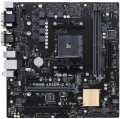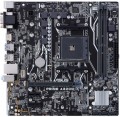Size (HxW)
Motherboard dimensions in height and width. It is assumed that the traditional placement of motherboards is vertical, so in this case one of the dimensions is called not the length, but the height.
Motherboard sizes are largely determined by their form factors (see above), however, the size of a particular motherboard may differ slightly from the standard adopted for this form factor. In addition, it is usually easier to clarify the dimensions according to the characteristics of a particular motherboard than to look for or remember general information on the form factor. Therefore, size data can be given even for models that fully comply with the standard.
The third dimension — thickness — is considered less important for a number of reasons, so it is often omitted.
PCI slots
The number of PCI slots provided in the design of the motherboard.
These slots are used for expansion cards. At the same time, technically, this interface is considered obsolete — in particular, it is noticeably inferior to the newer PCI-E in terms of data transfer speed (up to 533 MB / s). Nevertheless, for some types of components (for example, sound cards), such features are quite enough; and the use of PCI allows you to leave free PCI-E slots that may be needed for more demanding peripherals. So even nowadays, both motherboards with PCI slots and components with such a connection can still be found on the market.
DVI output
The motherboard has its own
DVI output; this clause also specifies the specific form of this interface.
Such an output is intended for transmitting video from an integrated graphics card (see above) or a processor with integrated graphics (we emphasize that it is impossible to output a signal from a discrete graphics card through the motherboard chipset). As for DVI specifically, this is a standard originally created for digital video devices, however, it also allows an analogue signal format, depending on the type. In modern computer technology, including motherboards, you can find two types of DVI:
— DVI-D. A standard that provides for the transmission of a signal only in digital form. Depending on the supported mode, the maximum resolution of such video can be 1920x1200 (single-link Single Link) or 2560x1600 (two-channel Dual Link); however, Single Link plugs can be connected to Dual Link ports, but not vice versa. Also note that such connectors are compatible with HDMI via adapters, while in some cases even sound transmission may be provided (although this function is not initially supported in DVI-D, and its availability should be specified separately).
— DVI-I. A standard that combines the DVI-D described above with analogue DVI-A and allows the signal to be output in both digital and analogue formats. DVI-A in its characteristics corresponds to VGA (see above): it supports resolutions up to 1280x1024
...inclusive and allows you to connect VGA screens through a simple adapter.HDMI version
HDMI connector version (see above) installed in the motherboard.
— v.1.4. The earliest of the standards found nowadays, which appeared back in 2009. Supports resolutions up to 4096x2160 inclusive and allows you to play Full HD video with a frame rate of up to 120 fps — this is enough even for 3D playback.
— v.1.4b. A modified version of v.1.4 described above, which introduced a number of minor updates and improvements — in particular, support for two additional 3D formats.
— v.2.0. Also known as HDMI UHD, this version introduced full 4K support, with frame rates up to 60 fps, as well as the ability to work with 21:9 ultra-widescreen video. In addition, thanks to the increased bandwidth, the number of simultaneously reproduced audio channels has grown to 32, and audio streams to 4. And in the v.2.0a improvement, HDR support has also been added to all this.
— v.2.1. Another name is HDMI Ultra High Speed. Compared to the previous version, the interface bandwidth has really increased significantly — it is enough to transmit video at resolutions up to 10K at 120 frames per second, as well as to work with the extended BT.2020 colour space (the latter may be useful for some professional tasks). HDMI Ultra High Speed cables are required to use the full capabilities of HDMI v2.1, but older standard features are available with regular cables.
COM port
Also known as
RS-232C. Initially, it was used to connect various peripherals (in particular, modems and mice), but due to the spread of USB, this function has practically lost. At the same time, various specialized devices continue to be equipped with connectors of this type — in particular, uninterruptible power supplies, cash equipment and even TVs, where it is used as a control port. Therefore, motherboards with a COM interface are still on the market.

